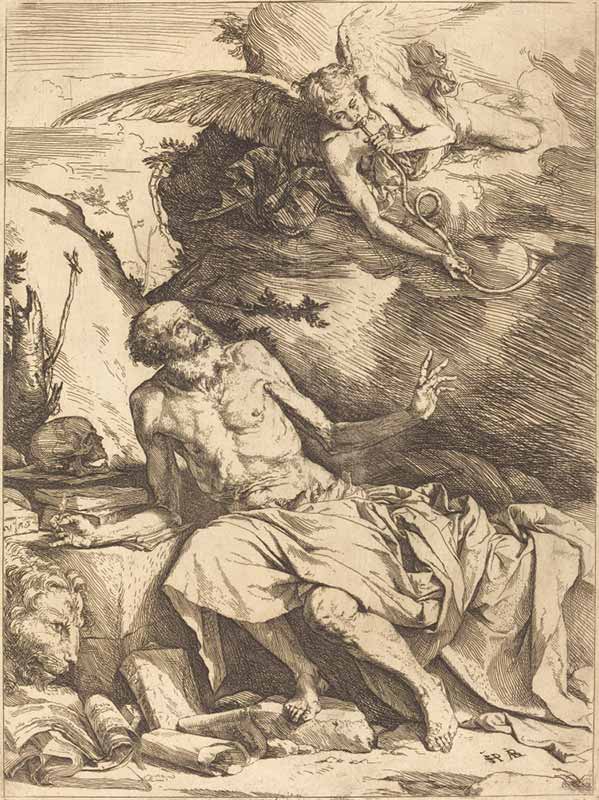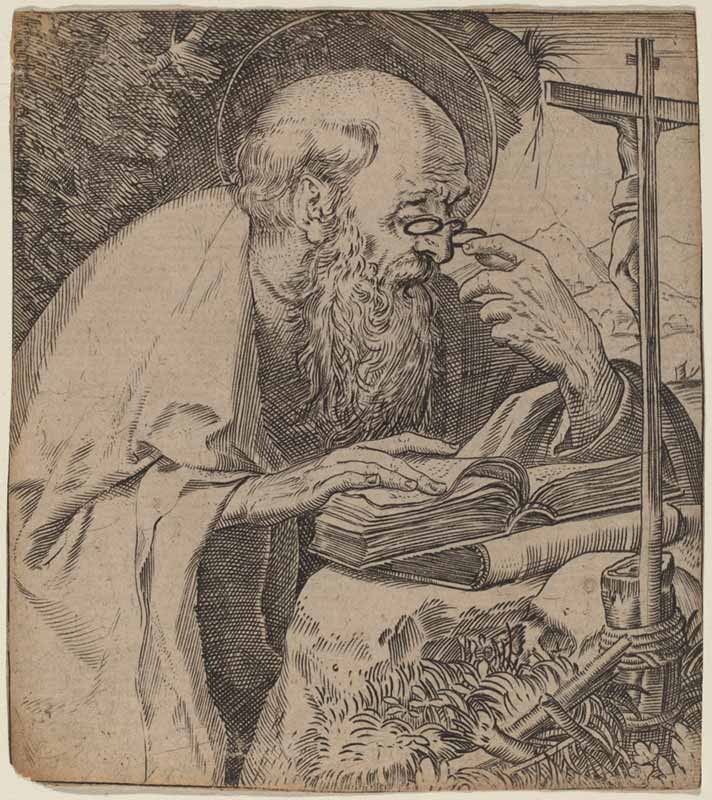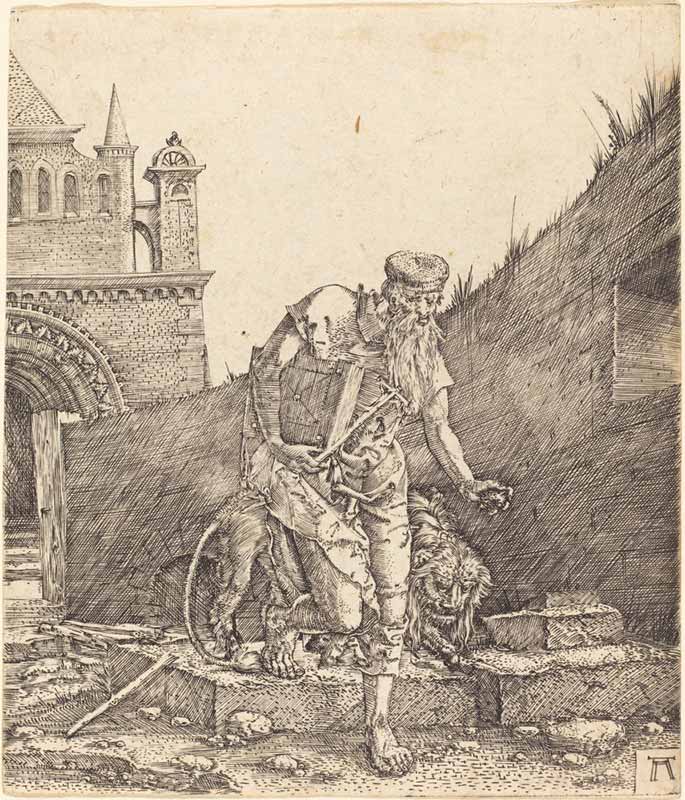1/ I have found myself thinking about Saint Jerome, the fourth and fifth-century Christian priest who, it is said, translated the Bible into Latin. For centuries, artists have most often portrayed Jerome as working in wilderness, cut off from civilization by wilds (early accounts of his life suggest he spent years living in the Syrian desert); alternately he is pictured working alone in his study, closed off from the outside world, surrounded by books and his own writing. Many American art museums have done extraordinary work making their collections available digitally, I've been surfing through them to Jeromes.
 Jusepe di Ribera, Saint Jerome Hearing the Trumpet of the Last Judgment, c. 1621, etching and engraving, plate: 31.7 x 23.8 cm (12 1/2 x 9 3/8 in.), sheet: 36.8 x 28.9 cm (14 1/2 x 11 3/8 in.), Brown 1973, no. 5, State i/v, Rosenwald Collection
Jusepe di Ribera, Saint Jerome Hearing the Trumpet of the Last Judgment, c. 1621, etching and engraving, plate: 31.7 x 23.8 cm (12 1/2 x 9 3/8 in.), sheet: 36.8 x 28.9 cm (14 1/2 x 11 3/8 in.), Brown 1973, no. 5, State i/v, Rosenwald Collection
2/ Here's one such image from the collection of the National Gallery of Art, a 1621 print by Jusepe de Ribera. I love how Ribera shows an angel as both inspiring and distracting Jerome. Writers can relate.
3/ I discovered that my YouTube TV queue still contains the entire 2019 women's World Cup. I've been watching a match each day. I've particularly enjoyed watching the Dutch, the French and the Spanish, but still: our own Megan Rapinoe is goddess, Rose Lavelle is deputy goddess, and Crystal Dunn is the goddess of speed.
4/ I've been reading. I'm working on book and exhibition projects that examine how artists impacted the American address of landscape, particularly during the late antebellum period and the Civil War, particularly around the invention of the national park at Yosemite in 1860-65. I'm reading is David Lowenthal's 2000 biography of pioneering conservationist George Perkins Marsh. I'm reading it along with Eleanor Jones Harvey's extraordinary, expansive, coffee-table-sized exhibition catalogue for "Humboldt and the United States," which would be on view at the Smithsonian American Art Museum (if it were open).
5/ To give myself a break from artists and American landscape, I curl up with books about my favorite artist, Henri Matisse. Over the weekend I re-read parts of Robin Mitchell's fascinating new "Venus Noire: Black Women and Colonial Fantasies in Nineteenth-Century France" and thought about how Matisse would have lived and known everything about which Mitchell wrote, and about how he responded to it quite differently at different parts of his career. (Among those works: the Nasher's 1907 Two Negresses and Reclining Nude I (Aurora).)
 Annibale Carracci, Saint Jerome, 1583/1585, engraving on laid paper, sheet: 9.5 x 8.8 cm (3 3/4 x 3 7/16 in.), Bohlin 1979, no.4, Gift of Kate Ganz
Annibale Carracci, Saint Jerome, 1583/1585, engraving on laid paper, sheet: 9.5 x 8.8 cm (3 3/4 x 3 7/16 in.), Bohlin 1979, no.4, Gift of Kate Ganz
6/ I love this 1583-85 Annibale Carracci print of Jerome, in which Jerome foregoes devotion in order to study. It's also at the National Gallery.
7/ I'm a huuuuuge fan of women's tennis, which like all global sport is temporarily shut down. Late last week I re-watched one of my favorite matches of 2019, Elina Svitolina's defeat of soon-to-be French Open champion Ash Barty at Indian Wells. I was in the stands for the match. It lasted 3 hours, 30 minutes, both players had match points galore. It ranks among the finest matches I've seen in thirty-something years of WTA fandom.
8/ I have read every one of P.G. Wodehouse's Bertie and Jeeves stories 50 times; they still make me laugh. I've been re-re-re-re-reading How Right You Are Jeeves (which was originally titled Jeeves in the Offing). I particularly noted Bertie's aside about how he had failed to respond to a dig from his Aunt Dahlia: "I should probably have said something pretty cutting in reply to this, if I could have thought of anything, but as I couldn't I didn't." We've all been there.
9/ My friend and colleague Jillian Steinhauer just sent out her periodic newsletter. It included a link to her review of a retrospective of the Puerto Rico-based Cuban artist Zilia Sánchez. I saw the show last year at Washington's Phillips Collection, and thought it was one of the best exhibitions of 2019, a beginning-to-end thrill. Steinhauer's review (in print) prompted me to spend my lunch hour with curator Vesela Sretenovic´'s exhibition catalogue. An absolute delight.
 Albrecht Altdorfer, Saint Jerome in a Courtyard, c. 1512/1515, engraving, New Hollstein, no. e. 24, State only, Rosenwald Collection
Albrecht Altdorfer, Saint Jerome in a Courtyard, c. 1512/1515, engraving, New Hollstein, no. e. 24, State only, Rosenwald Collection
10/ Of the 160-odd prints of Jerome I looked at over the weekend, my favorite is this one, by Albrecht Altdorfer in 1512-1515. (Once again, it's at the NGA.) As Altdorfer was known for being one of the pioneers of European landscape painting, you might expect him to have sited Jerome in a spectacular wilderness. Indeed, in other prints he did just that. But in this one, Jerome's just leaving the city on his way out to the wilderness. Altdorfer trusts that we know the story, so he just shows us Jerome going to work.